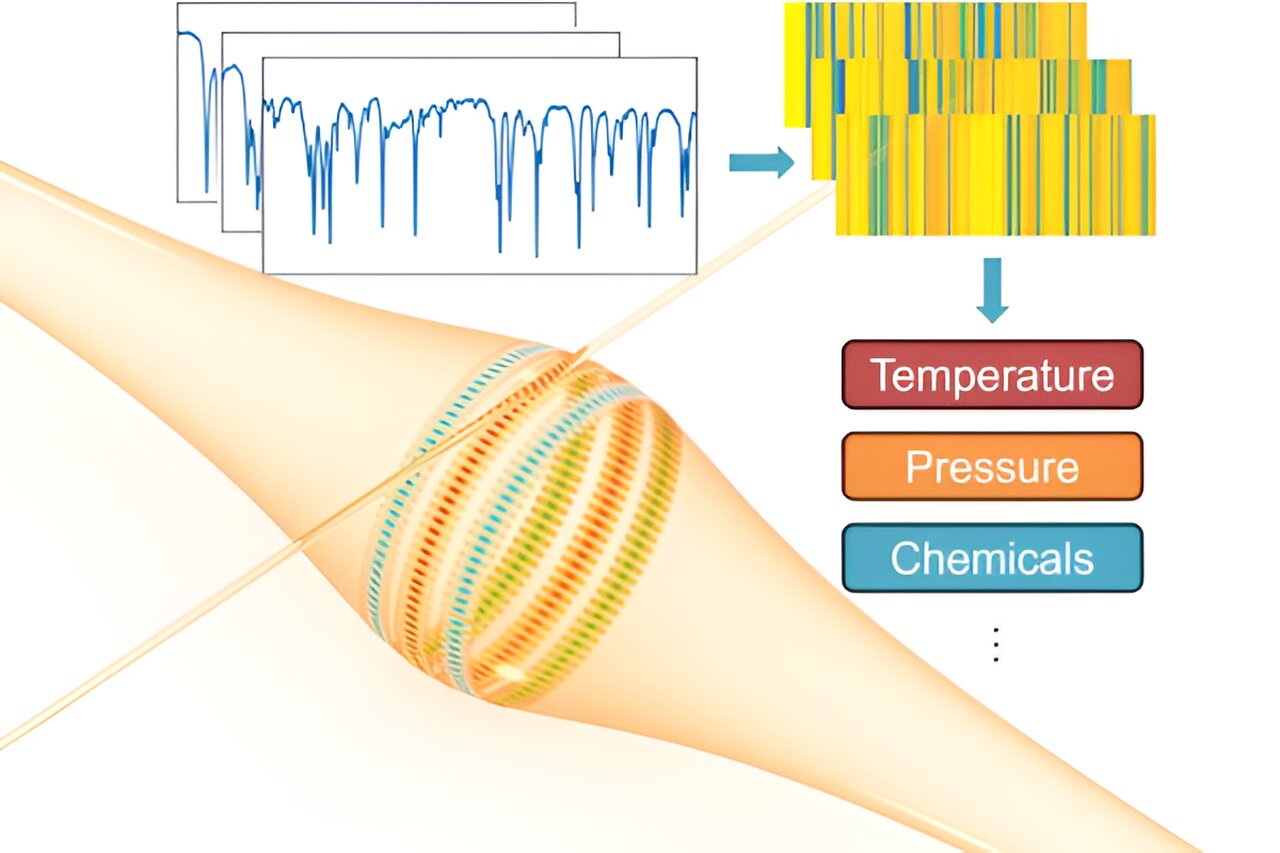An innovative optical sensor technology developed in Young’s lab at the McKelvey School of Engineering uses multimode resonance to enhance sensing capabilities. By analyzing patterns in the resonance spectrum, the innovative barcode technique provides detailed information about the sensor’s surroundings, offering increased dynamic range and accuracy in a variety of sensing applications. Credit: Young Labs
x to close
An innovative optical sensor technology developed in Young’s lab at the McKelvey School of Engineering uses multimode resonance to enhance sensing capabilities. By analyzing patterns in the resonance spectrum, the innovative barcode technique provides detailed information about the sensor’s surroundings, offering increased dynamic range and accuracy in a variety of sensing applications. Credit: Young Labs
The same geometric ambiguity that allows visitors to whisper messages around the circular dome of the Whispering Gallery at St. Paul’s Cathedral in London or the humming arch of St. Louis Union Station also enables high-resolution optical sensors. Whispering gallery mode (WGM) resonators have been used for decades to detect chemical signatures, DNA strands, and even single molecules.
In the same way that the architecture of a humming gallery bends and focuses sound waves, WGM resonators confine and focus light into a small circular path. This enables WGM resonators to detect and quantify physical and biochemical properties, making them ideal for high-resolution sensing applications in areas such as biomedical diagnostics and environmental monitoring.
However, the widespread use of WGM resonators is limited by their narrow dynamic range as well as their limited resolution and accuracy.
In a recent study published in the journal IEEE Transactions on Instrumentation and MeasurementLan Yang, the Edwin H. & Florence G. Skinner Professor, and Jie Liao, a postdoctoral research associate, both in the Preston M. Green Department of Electrical and Systems Engineering at the McCloy School of Engineering at Washington University in St. Louis, a A transformative approach to overcome these limitations presents: WGM optical barcodes for multimode sensing.
Liao and Yang’s innovative technique enables the simultaneous monitoring of multiple resonant modes in a WGM resonator, taking into account the distinct responses of each mode, greatly expanding the range of achievable measurements.
WGM sensing uses a specific wavelength of light that can travel around the microresonator medium millions of times. When the sensor encounters a molecule, the resonant frequency of the circulating light changes. Researchers can then measure this change to detect and identify the presence of specific molecules.
“The multi-mode trench allows us to capture multiple resonance variations in wavelength, not just one,” Liao explained. With multiple modes, we can extend WGM optical sensing to a wider range of wavelengths, achieve greater resolution and precision, and ultimately sense more particles.
Liao and Yang found the theoretical limit of WGM detection and used it to estimate the sensing capabilities of a multi-mode system. They compared conventional single-mode with multi-mode sensing and found that while single-mode sensing is limited to a very narrow range—about 20 picometers (pm) limited by the laser hardware—the range of multi-mode sensing using of the same settings is potentially unlimited.
“More resonance means more information,” Liao said. “We obtained a theoretically infinite range, although we are practically limited by the measuring device. In this study, the experimental limit we found with the new method was about 350 times larger than the conventional method for measuring WGM.”
Commercial applications of WGM multimode sensing could include biomedical, chemical and environmental applications, Yang said. For example, in biomedical applications, researchers can detect subtle changes in molecular interactions with unprecedented sensitivity to improve disease diagnosis and drug discovery.
In environmental monitoring, with the ability to detect minor changes in environmental parameters such as temperature and pressure, multimode sensing can enable early warning systems for natural disasters or facilitate monitoring of air and water pollution levels.
This new technology also allows for continuous monitoring of chemical reactions, as demonstrated in recent experiments conducted by Yang’s group. This capability holds promise for real-time analysis and control of chemical processes, offering potential applications in fields such as pharmaceuticals, materials science, and the food industry.
Liao added, “The ultra-high sensitivity of WGM resonators allows us to detect single particles and ions, but the potential of this powerful technology has not been fully exploited because we cannot directly use this ultra-sensitive sensor. to measure the complete unknown.”
Multi-mode sensing allows us to look into the unknown. By expanding our dynamic range to look at millions of particles, we can take on more ambitious projects and solve real-world problems.
more information:
Jie Liao et al., Multimode Sensing by Optical-Whisper-Gallery Mode Barcodes: A New Path to Dynamic Range Expansion for High-Resolution Measurement, IEEE Transactions on Instrumentation and Measurement (2024). DOI: 10.1109/TIM.2024.3352712
Magazine information:
IEEE Transactions on Instrumentation and Measurement
#Optical #barcodes #extend #range #high #resolution #sensors
